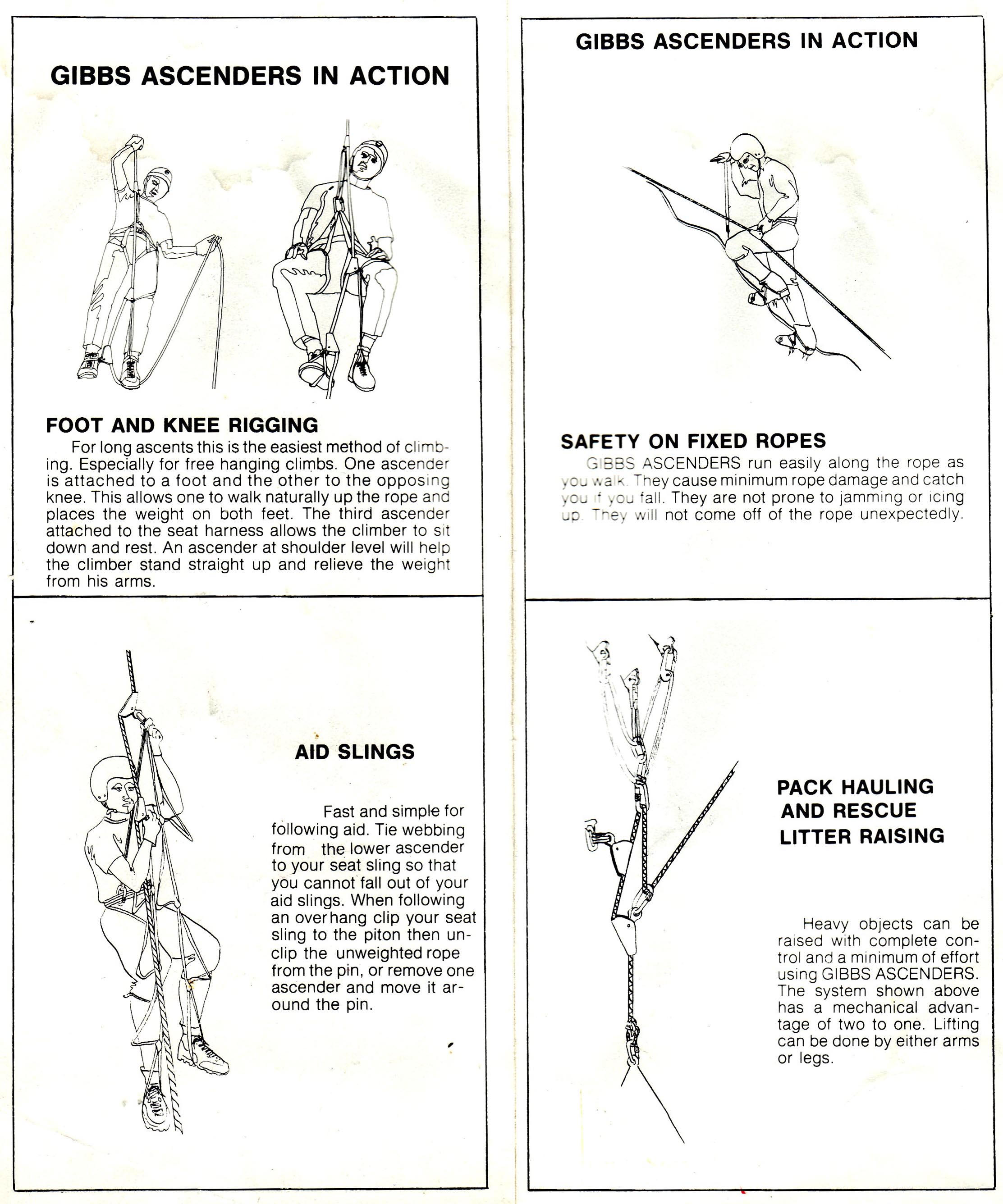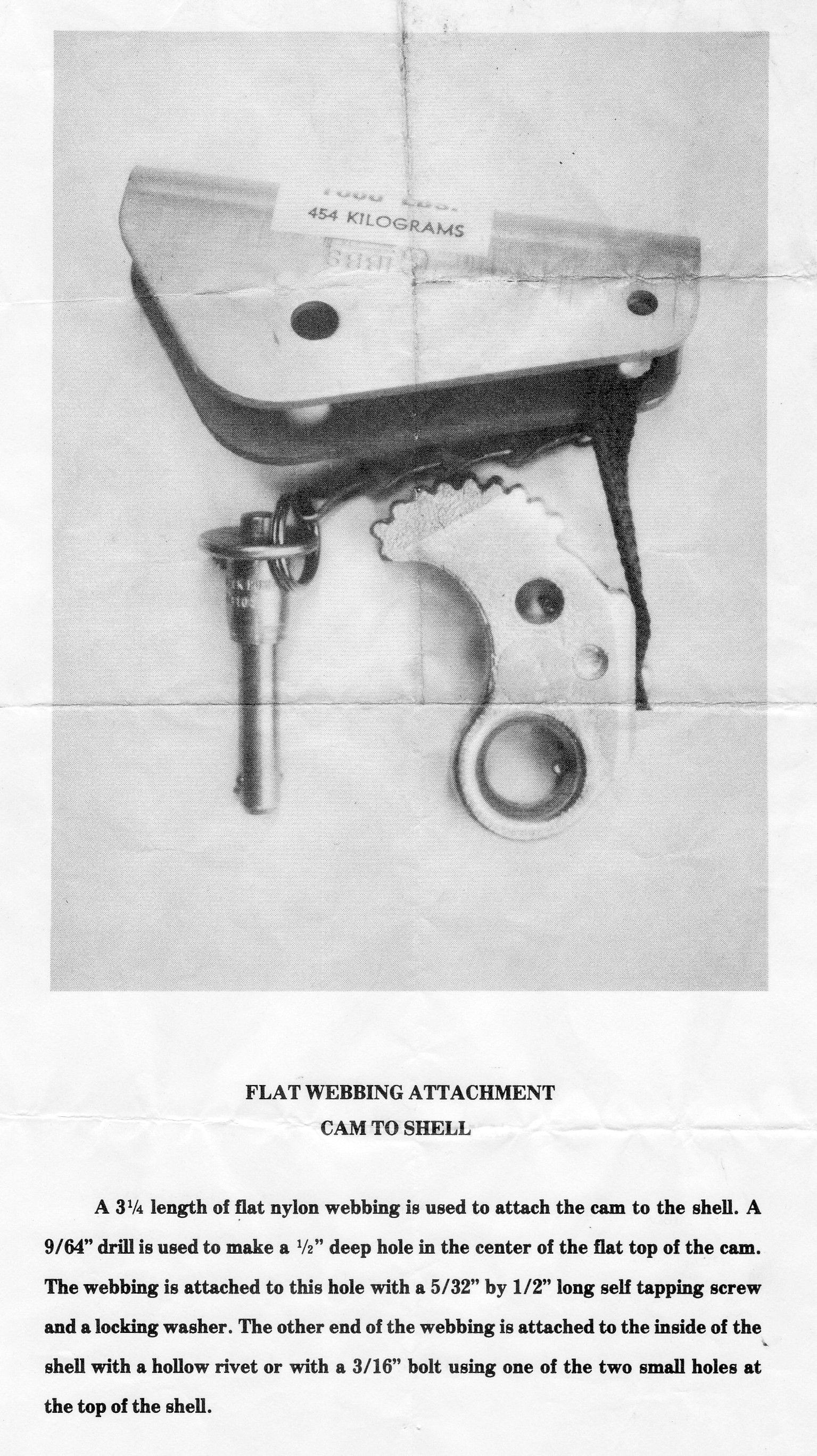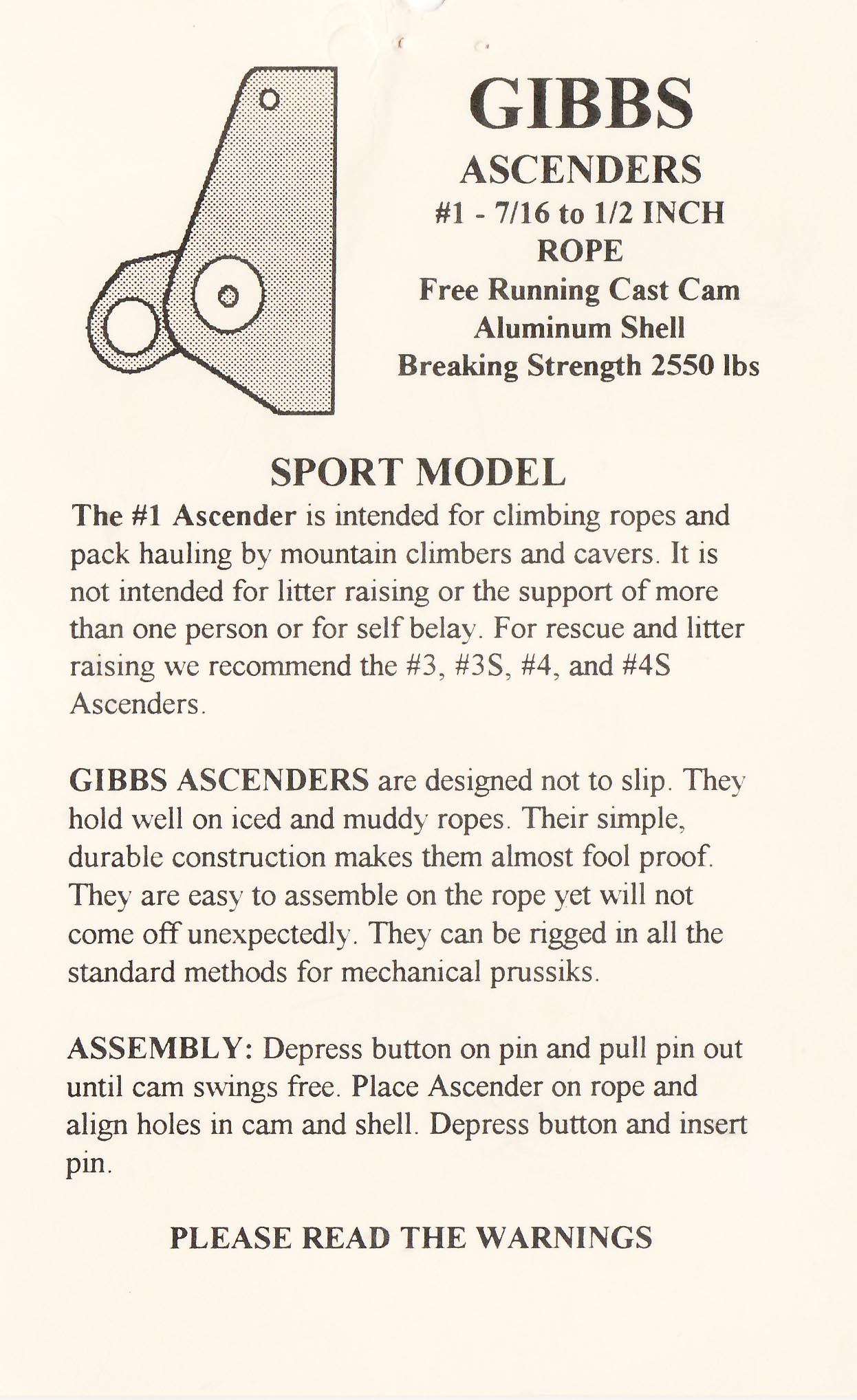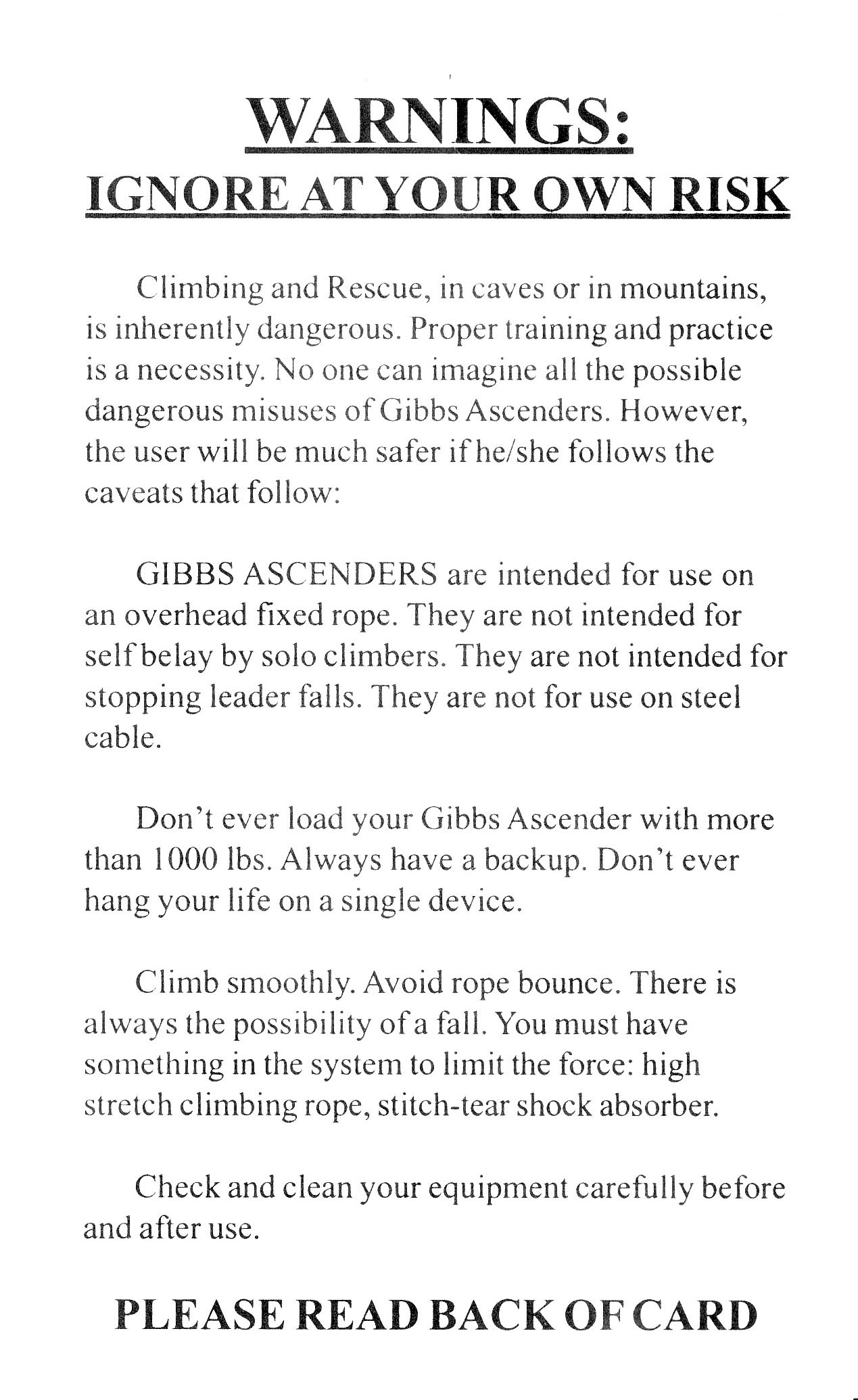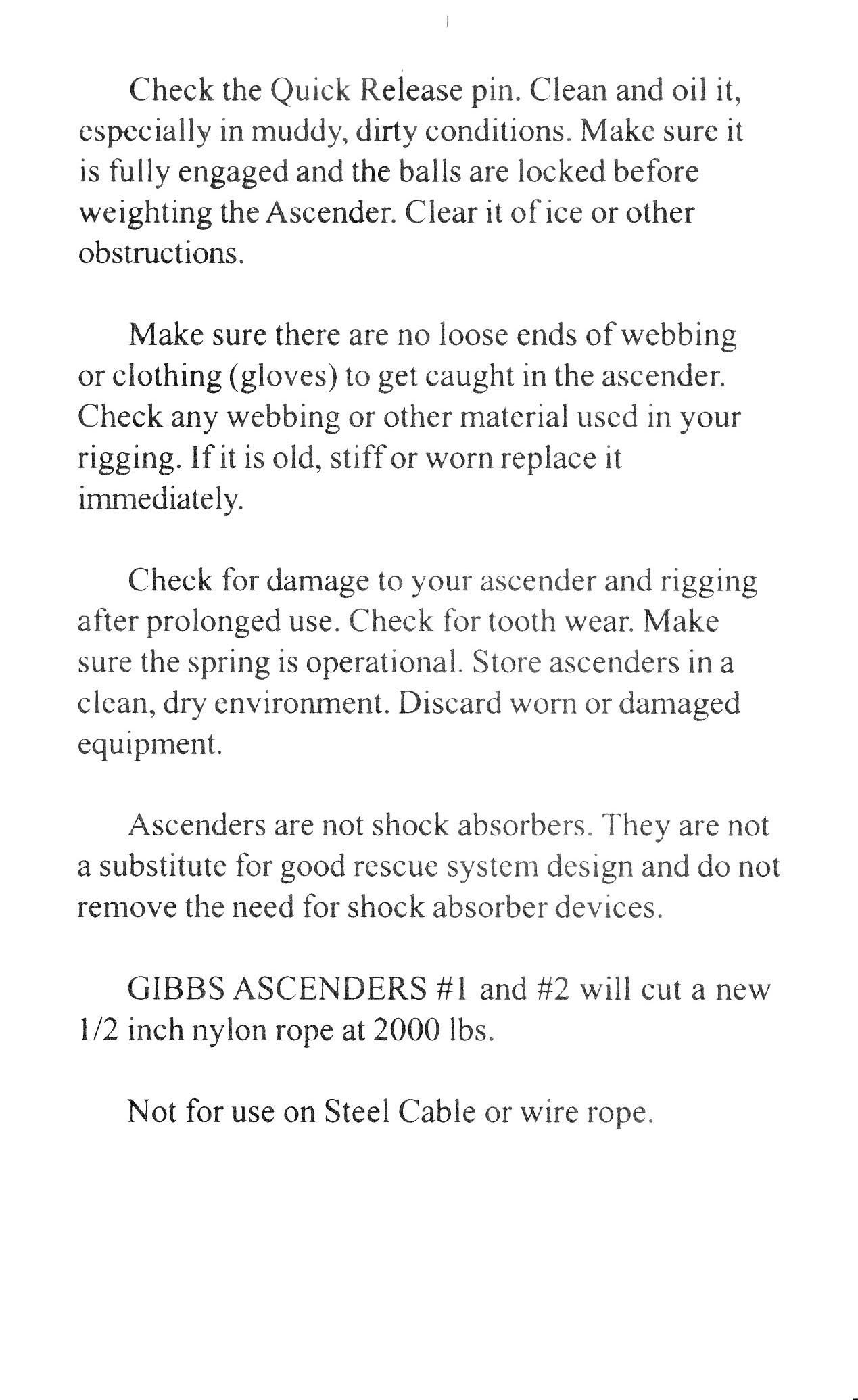Overview
The quick release (QR) pin models superceded the spring-wire models. Despite their being quicker, there were initial concerns about their behavior in muddy conditions; however, cavers eventually learned to accept and prefer them. Here is a quick summary of the versions in my collection (all have anodized aluminum shells unless otherwise noted):
- A. Ribbed "racing" cam, tied cord cam keeper, chain QR pin keeper.
(#2344)
- B. Cord cam keeper inserted into top of cam.
(#209, 224, 2258, 2395)
- C. Braided webbing cam keeper screwed to top of cam, chain QR pin keeper.
(#65, 286, 1543, 3554)
- D. Black cam, labeled arrows on shell.
(#1930)
- E. Stainless steel shell designed for coil spring, washer on rivet holding chain to shell.
(#2047)
- F. Large split ring on QR pin keeper
(2246)
- G. Plain shell, washer on rivet holding chain to shell, plated chain.
(#2045)
- H. Large split ring on QR pin keeper, copper-plated chain
(2242)
- I. Plain shell, tubular webbing cam keeper
(#2046)
- J. Stainless steel shell designed for coil spring, hard-coated cam, cable QR keeper attached to teardrop riveted to shell.
(#1918)
- K. Stainless steel shell designed for coil spring, punched cam, cable QR keeper attached to teardrop riveted to shell.
(#1918)
- L. Aluminum shell designed for wire spring, hard-coated cam, cable QR keeper attached outside teardrop riveted to shell.
(#66, 113)
- M. Like Version L but cam keeper sandwiched under teardrop.
(#1916,2983)
- N. New cam design, web cam keeper riveted to top of shell.
(#1561)
- O. Web cam keeper riveted to middle of shell.
(#1511)
- #1. New cam design, dented shell.
(#205, 2247)
[ Top
| Version B
| Version C
| Version D
| Version E
| Version F
| Version G
| Version H
]
[ Version I
| Version J
| Version K
| Version L
| Version M
| Version N
| Version O
| #1
| Return to L.C. Ascenders
]
Version A
(#2344)
Technical Details
I acquired my Gibbs QR, Version A from Bill Liebman at the 2017 Old Timers Reunion.
Version A is 103 mm.
tall, 58 mm.
wide, 57 mm.
thick, and weighs 172 g.
The shell is bent from 3.2 mm. aluminum sheet and then
anodized gold. The rope channel is 17 mm.
wide. The shell has
an 8.4 mm. through hole for the cam axle located 29 mm.
from the inside of the shell groove. One side of the shell has a semi-tubular rivet near the top that holds the cam and pin keepers. The other side has one that holds an electrical ring terminal that serves as an attachment for the cam keeper cord.
The cam is cast aluminum. It has nine teeth on a spiral face
that increases in radius from 16 to 34 mm. over about 89°,
giving a cam angle of about 28°
The cam axle is a 7.8 mm. quick release pain with a 25 mm.
active length. The pin keeper is six links of flat chain attached
to the pin by an 18.8 mm. split ring.
Each side of the shell is stamped with "GIBBS" with a double underline. The quick release pin is stamped "AVDEL PAT. PEND."
and "PUSH BLS5B10S."
This is the earliest quick-release Gibbs ascender in my collection. It features the ribbed "racing" cam. The cam keeper supplied with the ascender is a soft synthetic cord. As supplied, it came inserted through the ring terminal connector on the shell, but the buyer was responsible for tying the cord to the cam.
[ Top
| Version A
| Version C
| Version D
| Version E
| Version F
| Version G
| Version H
]
[ Version I
| Version J
| Version K
| Version L
| Version M
| Version N
| Version O
| #1
| Return to L.C. Ascenders
]
Version B
(#209, 224, 2258, 2395)
Technical Details
I acquired one of Version B from Thomas Kopp in 2007, and two more from Richard Briggs a few months later, all used on eBay. I acquired another in 2017 as part of Bob Thrun’s collection, and another form Rick Banning at the 2019 NSS Convention.
The shell is bent from 3.2 mm. aluminum sheet and then
anodized gold. The internal width is 16.6 mm. The shell has
an 8.4 mm. through hole for the cam axle located 29 mm.
from the inside of the shell groove. There is a 4.9 mm. through
hole near the top of the shell. One side of the top through hole
has a semi-tubular rivet that holds the cam and pin keepers.
The cam is cast aluminum. It has nine teeth on a spiral face
that increases in radius from 14 to 33 mm. over about 89°,
giving a cam angle of about 28°. The red cord cam keeper fits
into a countersunk hole drilled in the top of the cam, and emerges
from a hole in the side, where a knot secures it.
The cam axle is a 7.8 mm. quick release pain with a 25 mm.
active length. The pin keeper is six links of flat chain attached
to the pin by an 18.8 mm. split ring.
Each side of the shell is stamped with "GIBBS" with a double underline. The quick release pin is stamped "AVDEL PAT. PEND."
and "PUSH BLS5B10S."
The early quick release pin Gibbs had some problems in muddy
conditions, but a change to the quick release pin seems to have
eliminated most of the complaints.
The one that Rick Banning gave me is a minor variation that has the keeper attached to the other side of the shell.
[ Top
| Version A
| Version B
| Version D
| Version E
| Version F
| Version G
| Version H
]
[ Version I
| Version J
| Version K
| Version L
| Version M
| Version N
| Version O
| #1
| Return to L.C. Ascenders
]
Version C
(#65, 286, 1543, 3554)
Technical Details
I acquired a pair of Version C in the 1970s (probably 1975), another pair on eBay from Henderson L. Holman IV in 2009, one from Phillip Harris on eBay in 2010, and one from Kelley Deem at the 2022 Old timers Reunion.
This version differs from Version B by having a braided keeper
that is similar to a piece of flat boot lace. A round head screw
fastens and washer hold the cam, and the other end of the web
is riveted to the shell.
Each side of the shell is stamped with "GIBBS" with a double underline. The quick release pin is stamped "AVDEL PUSH" and "BLS5B10S."
I don't like the web as much as the cord. Although I've broken
cords, the web feels awkward, probably only because it is shorter
than I would like.
One of my Version C ascenders has a cylindrical depression
cast in the side of the cam, but this might only indicate that
the mold was not filled properly.
[ Top
| Version A
| Version B
| Version C
| Version E
| Version F
| Version G
| Version H
]
[ Version I
| Version J
| Version K
| Version L
| Version M
| Version N
| Version O
| #1
| Return to L.C. Ascenders
]
Version D
(#1930)
Technical Details
Barbara Anne Am Ende gave me this ascender at the 2012 NSS Convention.
Version D is 104 mm. tall, 58 mm. wide, 57 mm. thick, and weighs 180 g.
This version differs from Version C by having a black painted cam.
Each side of the shell is stamped with "UP," an up-pointing arrow, and "GIBBS" with a double underline. The quick release pin is stamped "AVIBANK PUSH" and "BL5B105."
I am not certain that the black paint on the cam is original, but it does not look like it was spay-painted later. The paint is continuous under the screw holding the keeper, and also within the QR pin hole. This suggests that the paint was applied by immersion.
The labeled arrows on the shell appear for the first time on this version.
[ Top
| Version A
| Version B
| Version C
| Version D
| Version F
| Version G
| Version H
]
[ Version I
| Version J
| Version K
| Version L
| Version M
| Version N
| Version O
| #1
| Return to L.C. Ascenders
]
Version E
(#2047)
Technical Details
I acquired my Gibbs QR, Version E Gibbs from CarolJo Rushin-Elron at the 2016 NSS Convention.
Version E is 104 mm. tall, 58 mm. wide, 57 mm. thick, and weighs 175 g. The shell is made from 3.1 mm. stainless steel. A small tab is punched out near the base of one side. This tab serves no useful function on this model, but allows parts commonality with certain spring-loaded models with coil springs.
The cam is hard anodized. It has nine teeth on a spiral face
that increases in radius from 16 to 33 mm. over about 84°,
giving a cam angle of about 28°.
The cam keeper is 100 mm. piece of 11 mm. braided
webbing screwed to the cam and riveted to the shell.
The cam axle is a 7.8 mm. quick release pain with a 25 mm.
active length. The pin keeper is six links of flat chain attached
to the pin by an 11 mm. split ring.
Each side of the shell is stamped with "UP," an up-pointing arrow, and "GIBBS" with a double underline. The quick release pin is stamped "AVIBANK PUSH" and "BL5B105."
The stainless steel shell serves no useful purpose for normal caving, and adds unnecessary weight. The nonfunctional tab tends to catch on things when it shouldn't. If I were to use this ascender regularly, I would flatten the tab.
[ Top
| Version A
| Version B
| Version C
| Version D
| Version E
| Version G
| Version H
]
[ Version I
| Version J
| Version K
| Version L
| Version M
| Version N
| Version O
| #1
| Return to L.C. Ascenders
]
Version F
(#2246)
Technical Details
I acquired my Gibbs QR, Version F in 2017 as part of Bob Thrun’s collection.
Version F is 104 mm. tall, 59 mm. wide, 57 mm. thick, and weighs 179 g.
The pin keeper is attached
to the pin by an 18.8 mm. split ring.
Each side of the shell is stamped with "UP," an up-pointing arrow, and "GIBBS" with a double underline. The quick release pin is stamped "AVIBANK PUSH" and "BLS5B10S."
The anodizing on the cam is black instead of bronze-colored, and the split ring is larger than the one on Version E. Neither change affects performance.
[ Top
| Version A
| Version B
| Version C
| Version D
| Version E
| Version F
| Version H
]
[ Version I
| Version J
| Version K
| Version L
| Version M
| Version N
| Version O
| #1
| Return to L.C. Ascenders
]
Version G
(#2045)
Technical Details
I acquired my Gibbs QR, Version G Gibbs from CarolJo Rushin-Elron at the 2016 NSS Convention.
Version G is 103 mm. tall, 58 mm. wide, 57 mm. thick, and weighs 289 g.
Each side of the shell is stamped with "UP," an up-pointing arrow, and "GIBBS" with a double underline. The quick release pin is stamped "AVIBANK" and "55207."
Gibbs ascenders start to slip when the cam wears down to about
the seventh tooth. The hard coated cam will last much longer than
the uncoated cams. I still prefer to cut the two largest teeth
(#1 and #2) off my Gibbs because they do create noticeable drag,
especially on a foot cam at the bottom of a pit. I don't climb
on oversize ropes, and these teeth serve no useful purpose on
thinner ones.
[ Top
| Version A
| Version B
| Version C
| Version D
| Version E
| Version F
| Version G
]
[ Version I
| Version J
| Version K
| Version L
| Version M
| Version N
| Version O
| #1
| Return to L.C. Ascenders
]
Version H
(#2242)
Technical Details
I acquired my Gibbs QR, Version H in 2017 as part of Bob Thrun’s collection.
Version H is 104 mm. tall, 59 mm. wide, 57 mm. thick, and weighs 179 g.
The pin keeper is six links of flat copper-plated chain attached
to the pin by an 18.8 mm. split ring.
Each side of the shell is stamped with "UP," an up-pointing arrow, and "GIBBS" with a double underline. The quick release pin is stamped "AVIBANK PUSH" and "BLS5B10S."
The anodizing on the cam is black instead of bronze-colored, the chain has a copper plating, and the split ring is larger than the one on Version G. None of these changes affects performance.
Version I
(#2046)
[ Top
| Version A
| Version B
| Version C
| Version D
| Version E
| Version F
| Version G
| Version H
]
| Version J
| Version K
| Version L
| Version M
| Version N
| Version O
| #1
| Return to L.C. Ascenders
]
Technical Details
I acquired my Gibbs QR, Version I Gibbs from CarolJo Rushin-Elron at the 2016 NSS Convention.
Version I #3 is 103 mm. tall, 58 mm. wide, 57 mm. thick, and weighs 173 g.
Each side of the shell is stamped with "UP," an up-pointing arrow, and "GIBBS" with a double underline. The quick release pin is stamped "AVIBANK" and "55207."
I like the web keeper more than the "shoe string"
of Version B or the "boot lace" of Version C.
[ Top
| Version A
| Version B
| Version C
| Version D
| Version E
| Version F
| Version G
| Version H
]
[ Version I
| Version K
| Version L
| Version M
| Version N
| Version O
| #1
| Return to L.C. Ascenders
]
Version J
(#1918)
Technical Details
I acquired my Gibbs QR, Version J from Speleoshoppe in 2012 as new old stock
Version J is 103 mm. tall, 59 mm. wide, 57 mm. thick, and weighs 284 g. The rope channel is 19 mm. wide. The shell is made from 3.1 mm. stainless steel. A small tab is punched out near the base of one side. This tab serves no useful function on this model, but allows parts commonality with certain spring-loaded models with coil springs.
The cam is hard anodized. It has nine teeth on a spiral face
that increases in radius from 16 to 33 mm. over about 84°,
giving a cam angle of about 28°.
The cam keeper is 120 mm. piece of 12.8 mm. tubular
webbing screwed to the cam and riveted to the shell. The pin keeper
is a piece of 1.6 mm. steel cable with eye loops crimped
at each end and a short (13 mm.) plastic covered central
section. One eye passes through a hole in the pin, the other attaches
to a teardrop shaped aluminum tab riveted to the shell with the
cam keeper sandwiched in between.
Each side of the shell is stamped with "UP," an up-pointing arrow, and "GIBBS" with a double underline. The quick release pin is stamped "AVIBANK PUSH" and "55207-1."
I don't
like the pin keeper because it is stiff enough to sometimes
impede setting the pin, but this is a very minor nit-pick rather
than a serious criticism.
The "teardrop" adds another part that can snag on other pieces of equipment (another minor nit-pick).
My previous comments on the stainless steel shell apply to this one as well.
[ Top
| Version A
| Version B
| Version C
| Version D
| Version E
| Version F
| Version G
| Version H
]
[ Version I
| Version J
| Version L
| Version M
| Version N
| Version O
| #1
| Return to L.C. Ascenders
]
Version K
(#2317)
Technical Details
I acquired my Gibbs #4S, Version K from On Rope 1 in 2009.
The Gibbs QR, Version K is 104 mm. tall, 71 mm. wide, 63 mm. thick, and weighs 313 g. The rope channel is 18 mm. wide. The shell is made from 3.1 mm. stainless steel. A small tab is punched out near the base of one side. This tab serves no useful function on this model, but allows parts commonality with certain spring-loaded models with coil springs.
The cam is punched from 2024-T6 aluminum alloy plate and then machined. It has nine teeth on a spiral face
that increases in radius from 15 to 32 mm. over about 84°,
giving a cam angle of about 27°.
The cam keeper is 120 mm. piece of 12.8 mm. tubular
webbing screwed to the cam and riveted to the shell. The pin keeper
is a piece of 1.6 mm. steel cable with eye loops crimped
at each end and a short (13 mm.) plastic covered central
section. One eye passes through a hole in the pin, the other attaches
to a teardrop shaped aluminum tab riveted to the shell with the
cam keeper sandwiched in between.
Each side of the shell is stamped with "UP," an up-pointing arrow, and "GIBBS" with a double underline. The quick release pin is stamped "AVIBANK PUSH" and "BLS6B11S."
This Gibbs has a new cam design. At first
glance it appears to be milled from plate, but closer inspection
shows a parting line in the middle. My guess is that it is punched,
and then the eye and pivot holes are drilled. If so, it may be stronger than the cast cams. More important, it seems to work as well as they do.
[ Top
| Version A
| Version B
| Version C
| Version D
| Version E
| Version F
| Version G
| Version H
]
[ Version I
| Version J
| Version K
| Version M
| Version N
| Version O
| #1
| Return to L.C. Ascenders
]
Version L
(#66, 113)
Technical Details
I have two of Version L. I don't have records of where I acquired
the first one. Geary Schindel gave me the second one in 1992.
It was still a current model at that time.
The shell is similar to the shell on Version I, but it has
two extra holes. These have no effect on this ascender, but allow
using the same shell for this model and spring
loaded Version M. The inner width is slightly larger (17.5 mm.)
and the axle hole sits slightly farther out in the groove (31 mm.).
The cam keeper is 120 mm. piece of 12.8 mm. tubular
webbing screwed to the cam and riveted to the shell. The pin keeper
is a piece of 1.6 mm. steel cable with eye loops crimped
at each end and a short (13 mm.) plastic covered central
section. One eye passes through a hole in the pin, the other attaches
to a teardrop shaped aluminum tab riveted between the shell and
cam keeper.
Each side of the shell is stamped with "UP," an up-pointing arrow, and "GIBBS" with a double underline. The quick release pin is stamped "AVDEL PUSH" and "55207-1."
The differences in cam and shell dimensions between this and
Version K are insignificant.
[ Top
| Version A
| Version B
| Version C
| Version D
| Version E
| Version F
| Version G
| Version H
]
[ Version I
| Version J
| Version K
| Version L
| Version N
| Version O
| #1
| Return to L.C. Ascenders
]
Version M
(#1916, 2983)
Technical Details
I acquired one Gibbs QR, Version M from Hawill’s Ltd. in 2012 as new old stock, and another from Bill Liebman at the 2017 Old Timers Reunion.
Version M is 104 mm. tall, 57 mm. wide, 57 mm. thick, and weighs 192 g. The rope channel is 19 mm. wide. The shell is the same as the Version L shell. The QR pin is attached to a teardrop-shaped tab by a crimped 1.75 mm. stainless steel cable. The tab is riveted to the upper shell, with a flat washer to protect the tab and a piece of 13 mm. tubular webbing sandwiched between the tab and the shell. The other end of the webbing is screwed to the top of the cam. The cast, hard-coated cam is similar to the Version L cam. The cam radius increases from 16 to 34 mm. over an angle of 81°, giving a 28° cam angle.
Each side of the shell is stamped with "UP," an up-pointing arrow, and "GIBBS" with a double underline. The quick release pin is stamped "AVIBANK PUSH" and "55207-1."
The two holes on one side of the cam, near the QR pin, are for parts commonality. On the spring-loaded models with wire springs, these holes are used for mounting the spring housing. They serve no function on the plain model, and it is interesting that the cam is not drilled as it is on those models or on Version N.
[ Top
| Version A
| Version B
| Version C
| Version D
| Version E
| Version F
| Version G
| Version H
]
[ Version I
| Version J
| Version K
| Version L
| Version M
| Version O
| #1
| Return to L.C. Ascenders
]
Version N
(#1561)
Technical Details
I acquired my Gibbs QR, Version N from Robert Bowman in 2012.
Version N is 104 mm. tall, 58 mm. wide, 57 mm. thick, and weighs 163 g. The shell is the same as the Version L shell, and the cam and QR pins are attached to the shell with a single piece of 12.7 mm. tubular webbing riveted to the shell. The cast, hard-coated cam is similar to the Version J cam. It also has a small hole drilled above the eye; this allows using the same cam design for spring-loaded models with wire springs.
Each side of the shell is stamped with "UP," an up-pointing arrow, and "GIBBS" with a double underline. The quick release pin is stamped "AVIBANK PUSH" and "55207XX."
My complaint is with the webbing keepers.
[ Top
| Version A
| Version B
| Version C
| Version D
| Version E
| Version F
| Version G
| Version H
]
[ Version I
| Version J
| Version K
| Version L
| Version M
| Version N
| #1
| Return to L.C. Ascenders
]
 Version O
Version O
(#1511)
Technical Details
I acquired two Gibbs QR, Version O ascenders from Ben North in 2009.
Version O is 104 mm. tall, 58 mm. wide, 57 mm. thick, and weighs 167 g. The shell is the same as the Version L shell, and the cam and QR pins are attached to the shell with 12.7 mm. tubular webbing riveted to the shell. The cast, hard-coated cam is similar to the Version L cam, but has a slightly different shape. It also has a small hole drilled above the eye; this allows using the same cam design for spring-loaded models with wire springs.
Each side of the shell is stamped with "UP," an up-pointing arrow, and "GIBBS" with a double underline. The quick release pin is stamped "AVK 55207."
My complaint is with the webbing keepers. Gibbs Products never found a good solution to the keeper problem. Cord and webbing keepers wear out, and stiff cable keepers are awkward to use.
[ Top
| Version A
| Version B
| Version C
| Version D
| Version E
| Version F
| Version G
| Version H
]
[ Version I
| Version J
| Version K
| Version L
| Version M
| Version N
| Version O
| Return to L.C. Ascenders
]
#1
(#205, 2247)
Technical Details
I acquired this Gibbs from Inner Mountain Outfitters in 2006. I acquired another in 2017 as part of Bob Thrun’s collection.
This Gibbs has a new cam design (the same as the one on the
Gibbs #2 Version L). At first
glance it appears to be milled from plate, but closer inspection
shows a parting line in the middle. My guess is that it is punched,
and then the eye and pivot holes are drilled. The edges of the
eye are sharp. The cam is hard anodized. It has nine teeth on
a spiral face that increases in radius from 15 to 33 mm.
over about 97°, giving a cam angle of about 27°.
The shell has the dimples introduced on Gibbs
#2 Version C. That version is a much larger ascender so it
does not belong on this page.
The quick release pin diameter was increased to 9.3 mm.
One side of the shell is stamped with an arrow pointing up
and "UP," "GIBBS" with a double underline, and "NOT FOR SELF BELAY."
The other side is stamped with an arrow pointing up and "UP,"
"GIBBS" with a double underline, and "USE ONLY ON NON-METAL ROPE FROM 7/16
TO 1/2."
Overall, I think Version O was better designed and better made.
I suspect the changes were made to better fit the more lucrative
and bureaucratically controlled industrial market rather than
the caving market where Gibbs Products planted their roots.
[ Top
| Version A
| Version B
| Version C
| Version D
| Version E
| Version F
| Version G
| Version H
]
[ Version I
| Version J
| Version K
| Version L
| Version M
| Version N
| Version O
| #1
]



